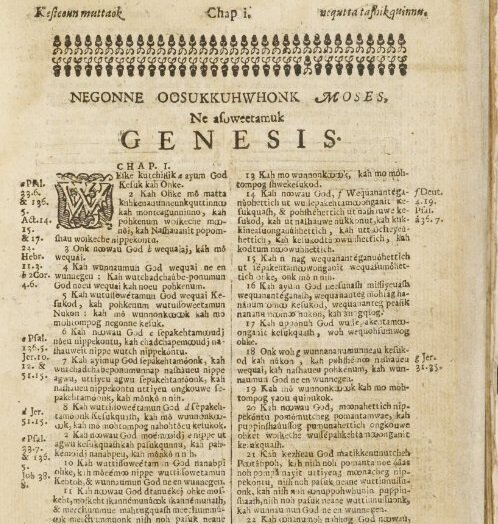
Natick and other "Praying Indian Towns" were founded by Rev. John Eliot, a Puritan missionary who preached for more than 20 years to the Algonquians of the Nipmuc, Massachusett, and Wampanoag tribes.
The Indigenous and English Roots of Natick
Rev. John Eliot, undated, unknown artist, Huntington Library
The founding of Natick has traditionally centered around stories of the Puritan minister John Eliot and the English mission to establish “Praying Towns.” However, the formation of these towns relied upon the leadership and collaboration of many Indigenous people, primarily from the Nipmuc and Massachusett nations. The origins of Natick begin in Nonantum (now Newton), a Massachusett village led by Waban. In 1646, John Eliot arrived at Waban’s longhouse to deliver God’s message and convert him and his people to Christianity. Waban invited Eliot to return to Nonantum to preach as long as Eliot would help secure land for his people at Nonantum. Eliot agreed, and Waban and his people converted to the Puritan faith. The conversion process included giving up many of their traditions and spiritual practices and embracing English customs and traditions.
Although Eliot could not secure rights to Nonantum through the Massachusetts General Court, he did secure land along the Quinobequin/Charles River to establish the first “Praying Town” called Natick in 1651. By design, Natick was to be an English settlement populated entirely by Indigenous people committed to conversion. Eliot believed that to become a Christian, Native people would have to embrace English gender roles and fashion, English-style farming and work habits, English systems of trade, and, of course, English habits of worship and faith. Although Waban and his followers wanted to stay at Nonantum, they agreed, for many reasons, to move to Natick. They were joined by another Massachusett leader, Custshamekin (initially based in Neponset), and John Speen, or Qualalanset, of the Nipmuc nation. To move to Natick, Eliot secured land rights from John Speen, who held rights to 2,000 acres along the river. At the same time, the Massachusetts General Court granted the town that same stretch of land—legal questions surrounding this land transfer endured for over a decade. Nonetheless, Natick residents quickly built homes (wetus), planted crops and orchards, fenced in livestock, and established a meeting house with a school run by a Massachusett schoolmaster named Monequassun.
Natick initially prospered under the leadership of Waban, Cutshamekin, John Speen, and other Indigenous leaders; Eliot continued his bi-weekly preaching in the first meetinghouse but never lived in Natick. Eliot went on to help establish more than a dozen other “Praying Towns” in eastern and central Massachusetts. Still, his primary responsibility was in Roxbury, where he was the teaching elder and then pastor of The First Church of Roxbury for almost 60 years. Day-to-day life in Natick was run entirely by Native people and elected leaders, including Christian religious life. Eliot trained several Native men to lead religious services, and one even became the first ordained Indigenous minister in North America: Daniel Takawambpait. Takawambpait led the Natick congregation after Eliot died in 1690, and the church gifted him a unique carved lectern that is a rare and early example of English-style furniture made by Indigenous people. It can be found on display at the Natick History Museum.
In his mission to convert Indigenous people, Eliot knew he would be most successful if he could preach in their native languages. Nipmuc and Massachusett languages were part of the Algonquian family and shared some basic similarities. Eliot’s first language teacher was Cockenoe, a Montauk captured by the English during the Pequot War and held captive in Dorchester. Cockenoe taught Eliot to speak Algonquian dialects, as there was no written form of Nipmuc or Massachusett. When Cockenoe left Eliot to return to his home on Long Island in New York, Job Nesuton, a Massachusett man, stepped in as Eliot’s new language teacher and interpreter. They worked together for 25 years until Job was killed in King Philip’s War.
Part of Eliot’s missionary vision was to offer Native people a bible in Algonquian so they could read the scripture in their language. The first edition of the bible, printed in 1663 at Harvard College (making it the first bible published in North America), took over a decade to complete. Although only Eliot’s name appears on the title page, the bible was collaborative. Several Indigenous linguists worked to translate the Old and New Testaments. Among them were Job Nesuton; James Printer, a Nipmuc man and printing apprentice studying at the Indian College at Harvard; Joel Iacoomes, an Aquinnah (now part of the Wampanoag) man studying at the Indian College at Harvard; and Caleb Cheeshateaumuck, a second Aquinnah man studying at the Indian College at Harvard. The Natick Historical Society holds a second edition (1685) of the Algonquian Bible in its collections. In addition to the bible, Indigenous linguists worked with Eliot to produce an Algonquian language primer and translated catechism for Algonquian-speaking converts.
To read more about the history of the Nipmuc Nation and the Massachusett Nation, please visit their websites here: The Nipmuc Nation, The Massachusett Nation.
Selected sources and additional reading:
Natick Historical Society collections.
Bacon, Oliver N. A History of Natick, From Its First Settlement in 1651 to the Present Time; With Notices of the First White Families. Boston: Damrell & Moore, Printers, 16 Devonshire Street, 1856.
Brooks, Lisa. Our Beloved Kin: A New History of King Philip’s War. New Haven, CT: Yale University Press, 2018.
DeLucia, Christine M. Memory Lands: King Philip’s War and the Place of Violence in the Northeast. Yale University Press, 2018.
Mandell, Daniel R. King Philip’s War: Colonial Expansion, Native Resistance, and the End of Indian Sovereignty. Baltimore, MD: The Johns Hopkins University Press, 2010.
Morley, James W. From Many Backgrounds: The Heritage of the Eliot Church of South Natick. South Natick, MA: The Natick Historical Society, 2007.
O’Brien, Jean M. Dispossession by Degrees: Indian Land and Identity in Natick, Massachusetts, 1650-1790. Cambridge: Cambridge University Press, 1997.




